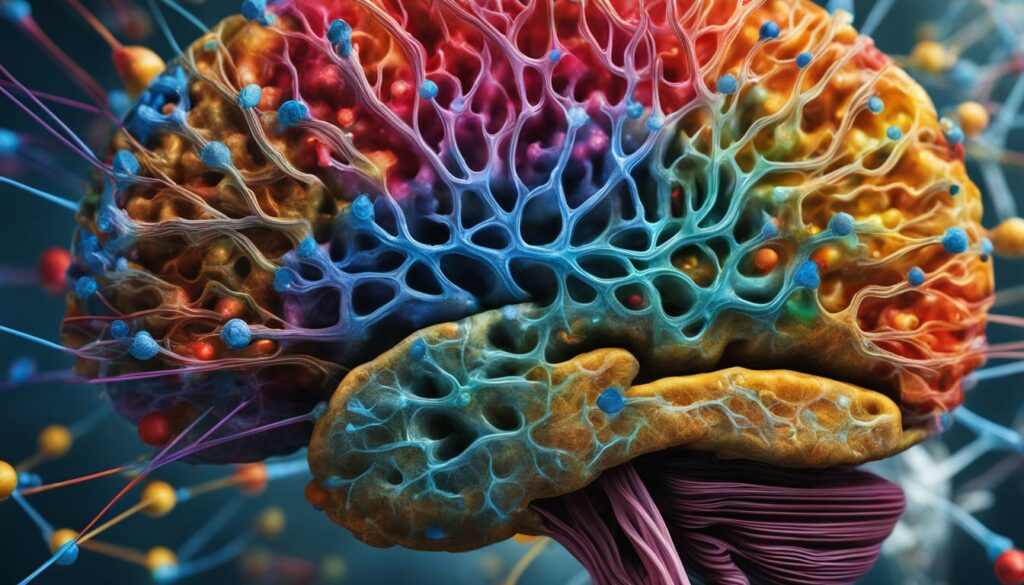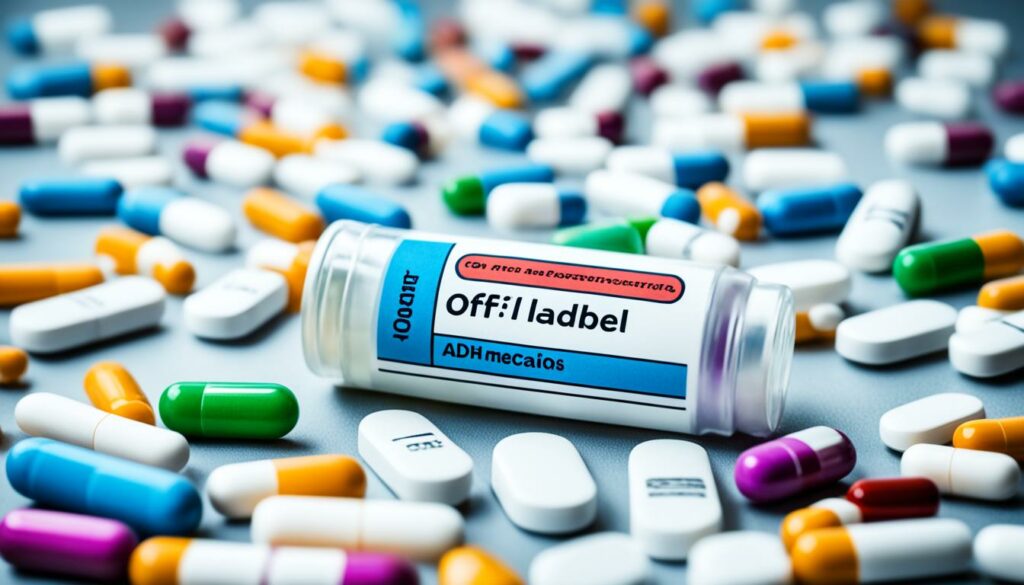Did you know that ADHD affects approximately 5-10% of children and 2-5% of adults worldwide? This neurodevelopmental disorder can have a significant impact on a person’s attention, focus, and impulse control, affecting their academic and occupational performance, as well as their daily functioning.
Understanding ADHD and finding effective treatments is crucial, which is why ADHD medications play a crucial role in managing symptoms. These medications work by targeting the neurotransmitters in the brain that are responsible for attention and executive functions. In this article, we will explore the mechanism of action behind ADHD drugs and shed light on how they work to improve ADHD symptoms.
Key Takeaways:
- ADHD affects a significant portion of the population, with an incidence of approximately 5-10% in children and 2-5% in adults.
- ADHD medications target the neurotransmitters in the brain responsible for attention and executive functions.
- Understanding how ADHD drugs work can provide valuable insights into the management of ADHD symptoms.
- Stimulant medications and nonstimulant medications are commonly used to treat ADHD.
- Individuals with ADHD may require a personalized approach to medication management to find the most effective treatment.
How Stimulant Medications Work for ADHD
Stimulant medications, such as amphetamines (Adderall, Dexedrine, DextroStat) and methylphenidate (Ritalin, Focalin, Methylin, Concerta), are the first line of treatment for ADHD. These medications work by increasing the levels of neurotransmitters, such as dopamine and norepinephrine, in the brain. By increasing the availability of these neurotransmitters, stimulant medications enhance focus, attention, and impulse control. They are available in both short-acting and long-acting formulas and have been shown to be effective in up to 80% of individuals with ADHD.
Stimulant medications are commonly prescribed for ADHD due to their proven effectiveness in managing symptoms and improving daily functioning. They are an important tool in the management of ADHD, allowing individuals to better focus on tasks, control impulsive behaviors, and regulate attention. Understanding the mechanism of action for stimulant medications can provide insight into how they work to alleviate ADHD symptoms.
Stimulant medications primarily work by targeting the levels of dopamine and norepinephrine in the brain. These neurotransmitters play key roles in various brain functions, including attention, motivation, and reward systems. In individuals with ADHD, there is often a deficit or imbalance of these neurotransmitters. Stimulant medications help normalize these levels, resulting in improved attention and decreased impulsivity.
When taken as prescribed, stimulant medications have been shown to significantly reduce ADHD symptoms and enhance cognitive abilities. They can improve focus, increase attention span, and promote organization and task completion. Research supports the effectiveness of stimulant medications in treating ADHD across different age groups, including children, adolescents, and adults.
The Mechanism of Action for Stimulant Medications
The precise mechanism of action for stimulant medications is complex and not fully understood. However, they primarily interact with the dopamine and norepinephrine transporters in the brain, which regulate the reuptake of these neurotransmitters. By blocking the reuptake process, stimulant medications increase the availability of dopamine and norepinephrine in the synaptic clefts, allowing for enhanced neurotransmission.
| Effects of Stimulant Medication | Description |
|---|---|
| Increased focus and attention | Stimulant medications help individuals concentrate and stay on task, reducing distractibility. |
| Improved impulse control | Stimulant medications can reduce impulsive behaviors and promote better decision making. |
| Enhanced organization and planning | These medications support improved executive functioning, allowing individuals to better manage and prioritize tasks. |
| Reduced hyperactivity | Stimulant medications can help calm excessive motor activity and restlessness associated with ADHD. |
Stimulant medications are available in various forms, including immediate-release, extended-release, and patch formulations. The choice of medication and formulation depends on individual needs and preferences, as well as the duration of symptom control required.
Stimulant medications have consistently shown efficacy in treating ADHD symptoms and improving overall functioning. They offer individuals with ADHD the opportunity to better manage their symptoms and thrive in various aspects of life.
It is important to note that stimulant medications should always be prescribed and monitored by a healthcare professional. Proper assessment, dosage adjustments, and regular check-ups are essential for safe and effective use.
While stimulant medications are highly effective for many individuals with ADHD, they may not be suitable for everyone. It is important to discuss potential side effects, contraindications, and alternative treatment options with a healthcare professional to make informed decisions about ADHD medication.
Nonstimulant Medications for ADHD
Nonstimulant medications, such as atomoxetine (Strattera), guanfacine (Intuniv), and clonidine (Kapvay), serve as alternative options for individuals who prefer nonstimulant treatments or do not respond well to stimulant medications.
These nonstimulant medications work through different mechanisms. Atomoxetine, for instance, is a serotonin-norepinephrine reuptake inhibitor (SNRI) that increases the levels of norepinephrine and serotonin in the brain. This helps regulate attention, impulse control, and hyperactivity associated with ADHD.
Guanfacine and clonidine, on the other hand, belong to a class of medications known as alpha-2 receptor agonists. These medications primarily target the prefrontal cortex, regulating the levels of norepinephrine to reduce inattention, hyperactivity, and impulsivity.

Nonstimulant medications provide an alternative treatment option for individuals who cannot or prefer not to take stimulant medications. It’s important to work closely with a healthcare or mental health professional to determine the most suitable medication for managing ADHD symptoms.
Next, we will explore off-label medications for ADHD that may be prescribed under certain circumstances.
Off-Label Medications for ADHD
In addition to stimulants and nonstimulants, there are other medications that may be prescribed off-label for ADHD. Antidepressants, such as bupropion, nortriptyline, desipramine, and venlafaxine, may be used to increase neurotransmitters like norepinephrine in the brain and improve ADHD symptoms.
These medications are often prescribed when there are coexisting conditions with overlapping symptoms, such as anxiety or depression.
It’s important to note that off-label use of medications should be done under the guidance of a healthcare or mental health professional.

Off-Label Medications for ADHD
| Medication | Common Brand Names | Medication Class | Mechanism of Action |
|---|---|---|---|
| Bupropion | Wellbutrin, Zyban | Antidepressant | Inhibits the reuptake of norepinephrine and dopamine |
| Nortriptyline | Pamelor | Tricyclic Antidepressant | Inhibits the reuptake of norepinephrine and serotonin |
| Desipramine | Norpramin | Tricyclic Antidepressant | Inhibits the reuptake of norepinephrine |
| Venlafaxine | Effexor | SNRI (Serotonin-Norepinephrine Reuptake Inhibitor) | Inhibits the reuptake of norepinephrine and serotonin |
Conclusion
ADHD medication management is a critical aspect of treating ADHD symptoms in both children and adults. Finding the right ADHD medication is essential for achieving optimal symptom control and enhancing daily functioning. Stimulant medications, such as Adderall and Ritalin, are frequently prescribed as the first line of treatment due to their effectiveness in improving focus, attention, and impulse control.
For individuals who cannot take stimulants or do not respond well to them, nonstimulant medications like Strattera and Intuniv provide alternative options. These medications work through different mechanisms, targeting neurotransmitters in the brain to reduce inattention, hyperactivity, and impulsivity. It’s important to note that the choice of medication depends on various factors, including individual response, medical history, and potential side effects.
In some cases, off-label medications, such as certain antidepressants, may be prescribed to manage ADHD symptoms. These medications can help increase neurotransmitter levels and address coexisting conditions like anxiety or depression. However, it’s crucial to work closely with a healthcare or mental health professional to ensure the safe and effective use of off-label medications.
When it comes to treating ADHD with medication, finding the right medication and dosage may require some trial and error. It’s essential to have ongoing communication with your healthcare provider, who will monitor your progress, make adjustments as needed, and provide guidance on ADHD medication management. With the appropriate medication and personalized treatment plan, individuals with ADHD can experience significant improvement in their symptoms and overall quality of life.
